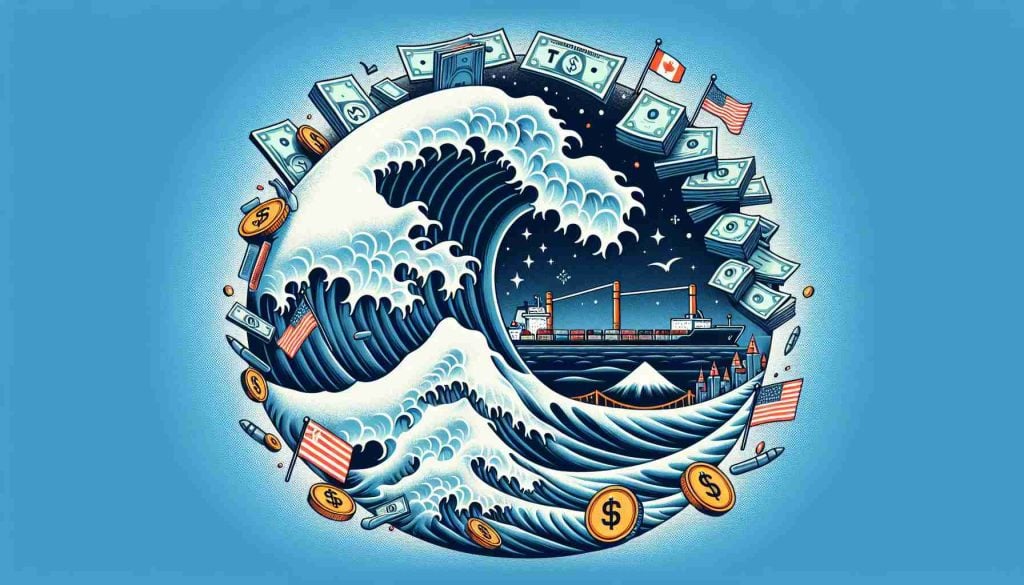- An impending 25% tariff on Canadian goods and a 10% tariff on energy products will begin on Tuesday.
- The tariffs are part of President Trump’s strategy to shift U.S. trade dynamics and reduce reliance on traditional allies.
- Canadian leaders, including Premier Doug Ford, are preparing retaliatory measures targeting products from U.S. Republican strongholds.
- Economic experts predict that increased tariffs may escalate prices for consumers in both Canada and the U.S.
- The situation underscores the potential volatility in North American trade relations, with significant implications for consumers and businesses.
- Both nations are in a precarious position, navigating the challenges posed by this trade conflict.
A seismic shift is looming over North American trade as the U.S. prepares to impose hefty tariffs on Canadian goods. Starting Tuesday, Canadian exports will face a 25% tax, while energy products will be hit with a 10% tariff. This bold move is part of a wider plan by U.S. President Trump to reestablish economic dominance by isolating the country from longstanding trade allies.
As these tariffs blanket an array of products—from fresh blueberries to intricate microchips—eyes are on Canada’s response. Provincial leaders, like Ontario’s Premier Doug Ford, are gearing up for a fiercely protective retaliation aimed directly at goods from Republican strongholds, targeting everything from high-grade nickel to notable craft beverages. The stakes are immense; these tariffs not only threaten the Canadian economy but could also ripple back to impact American families through rising costs on essentials like groceries and fuel.
As economic leaders express their concerns, they warn that these tariffs may harm both nations, with increased prices becoming a reality for consumers on both sides of the border. Canadians are urging for a quick resolution, while Trump’s administration remains firm on its agenda, sparked by the belief that the U.S. has been shortchanged for too long.
The takeaway? Brace yourself, as the intricate web of North American trade faces its toughest challenge yet, potentially altering how we shop, invest, and do business across borders. Stay tuned as this trade saga unfolds!
The Tariff Tug-of-War: How Will It Impact North American Trade?
A Looming Trade Crisis
A major economic shift is underway as the U.S. government prepares to impose significant tariffs on Canadian goods. Beginning Tuesday, Canadian exports will see a 25% tariff, while energy products will incur a 10% tax. This strategy is a part of President Trump’s broader initiative to reclaim economic dominance by distancing the U.S. from traditional trade partners.
The tariffs will cover a wide range of products, from fresh blueberries to complex microchips, signaling a significant disruption in supply chains. This trade war sets the stage for potential retaliatory measures by Canada, led by influential leaders like Ontario’s Premier Doug Ford. Their focus is on counteracting these tariffs by targeting U.S. goods, particularly from Republican states, showcasing a deeply politicized aspect of trade relations.
Market Forecasts and Insights
As analysts assess the implications, they warn of several potential outcomes:
– Increased Consumer Costs: The tariffs may lead to higher prices for basic goods in both Canada and the U.S., ultimately burdening American families with increased costs on groceries, fuel, and general consumer goods.
– Shift in Trade Dynamics: Canadian producers may look to diversify their markets beyond the U.S., potentially increasing trade with countries like China and EU nations.
– Long-term Economic Implications: Prolonged tariffs could establish deep rifts in international relations and may accelerate inflation rates as costs of imported goods rise.
Pros and Cons of the Tariff Strategy
Pros:
– Potentially boosts domestic manufacturing and jobs in the U.S.
– Aims to correct perceived trade imbalances.
Cons:
– Higher costs for consumers in both countries.
– Possible retaliatory tariffs could hurt U.S. exports, particularly agricultural products.
Key Questions Addressed
1. What are the immediate economic effects of the tariffs on Canadian exports?
The immediate effect will likely be a sharp increase in prices for goods exported from Canada to the U.S. Economic analysts foresee a rise in inflation as U.S. consumers feel the burden of higher costs.
2. How might Canada retaliate against these tariffs?
Canada may implement counter-tariffs on U.S. products, especially those from Republican states, targeting sectors crucial to U.S. exports like agriculture and manufacturing.
3. What could be the long-term implications of a sustained tariff regime?
If the tariffs remain in place, it could lead to a fundamental restructuring of trade relations in North America. Companies may alter supply chains to reduce dependency on cross-border trade, and trade balances could shift regionally and globally.
Sustained Economic Impact and Future Trends
As tensions escalate, both countries will need to navigate the complexities of this economic landscape. The future may see alternative trading alliances form as the U.S. and Canada weigh their options amidst a backdrop of increasing tariffs. Additionally, consumer sentiment will likely shift as people become more aware of the ramifications of these tariffs on their daily lives.
For in-depth insights on the evolving trade dynamics, visit Trade Watch.
As this situation unfolds, keep an eye on the latest developments as they will undoubtedly reshape how we conduct business and trade across North America.
